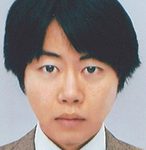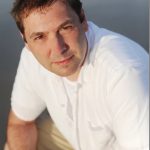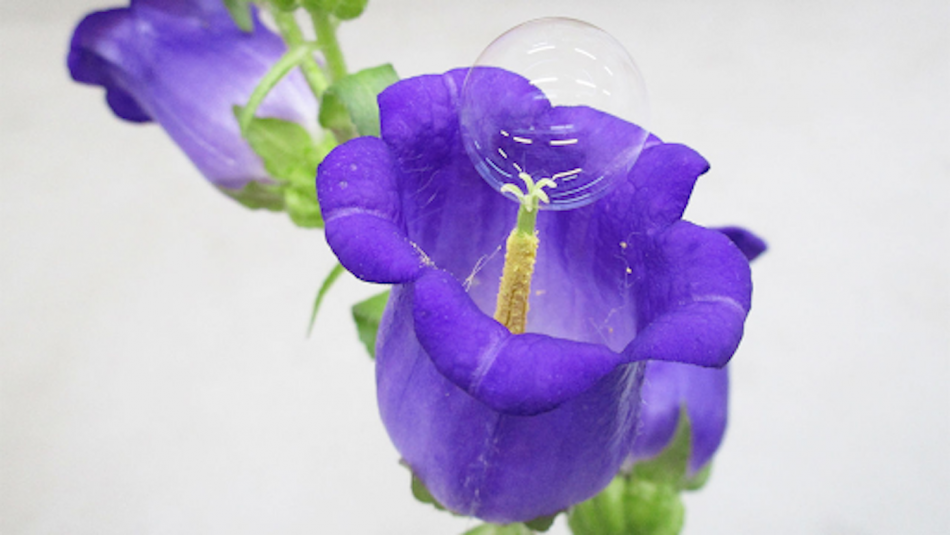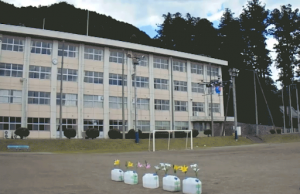
Image from Dr. Eijiro Miyako
This article and interview is a guest post by Sarah Krementz (S), a student in Rob Dunn’s course on the Future of Life. Sarah Krementz is a second year student originally from Greensboro, N.C. pursuing a B.S. in Fisheries, Wildlife, and Conservation Biology. She is passionate about conserving the future of all organisms and educating her community on the importance of natural resources. She plans to pursue a career in either wildlife research and management or working with our future generations and teaching them how to protect all species.
Pollination is an essential process for the world’s agricultural system and without wild and domesticated pollinators, humans would not be able to grow and harvest the crops we rely on. While there are many pollinator species, such as birds, bats, butterflies, wasps, and moths, the dominant pollinators in the world are wild and domesticated honey bees. The future of pollination is critical to the evolution of agriculture and the balance of these ecosystems. While humans have changed the processes of agriculture through time, bees have always been an essential part of growing crops. Close to 12,000 years ago, humans created an agricultural system that relied on wild pollinators, but we have bred and now often rely on domesticated honey bees. Different factors such as increased greenhouse gas emissions, increased temperatures, pesticides, pathogens, and parasites (varroa mites) threaten the population of wild and domesticated honey bees. Some experts in the field have begun to look for alternative solutions to the role that honey bees may not be able to fulfill in the future. Artificial pollination utilizing drones is a new upcoming technology with promise and could be the future if native pollinators are not able to sufficiently pollinate crops. So, what will pollination look like in the next 100 or even 1,000 years?
Since pollination is so necessary to the way humans have been sustaining themselves for centuries, I wanted to get a better understanding of how pollination will look in the future. Not only what will change in my lifetime, but many years beyond that as well. I wanted to push the boundaries of our pollination experts’ ideas and beliefs to see what they think will be different about their fields of expertise. I have had the pleasure of interviewing experts in different realms of the pollination field, Dr. Becky Irwin, Dr. Eijiro Miyako, and Dr. David Tarpy. With a multitude of experiences and research interests, these professionals have studied the ins and outs of native wild bees, domesticated honey bees, and artificial pollination.
 Dr. Becky Irwin (BI) is a professor at NC State’s Department of Applied Ecology as well as the director of NCSU’s Biology Graduate Program. Dr. Irwin’s lab at NCSU studies the ecological and evolutionary consequences of pollination mutualisms and their responses to environmental change. A community project that Dr. Irwin’s lab set up is the Bee Hotels on NC State’s campus where solitary bees are able to nest in urban environments, with an additional goal of educating local citizens about bee pollinator presence and importance.
Dr. Becky Irwin (BI) is a professor at NC State’s Department of Applied Ecology as well as the director of NCSU’s Biology Graduate Program. Dr. Irwin’s lab at NCSU studies the ecological and evolutionary consequences of pollination mutualisms and their responses to environmental change. A community project that Dr. Irwin’s lab set up is the Bee Hotels on NC State’s campus where solitary bees are able to nest in urban environments, with an additional goal of educating local citizens about bee pollinator presence and importance.
 Dr. Eijiro Miyako (EM) is an assistant professor in the School of Materials Science, at Japan Advanced Institute of Science and Technology (JAIST), and in addition, he runs the MIYAKO Lab which focuses on the creation of game-changing technology. A lot of Dr. Miyako’s work has been researching and developing drones that are fit to pollinate different types of vegetation by transferring pollen on soap bubbles.
Dr. Eijiro Miyako (EM) is an assistant professor in the School of Materials Science, at Japan Advanced Institute of Science and Technology (JAIST), and in addition, he runs the MIYAKO Lab which focuses on the creation of game-changing technology. A lot of Dr. Miyako’s work has been researching and developing drones that are fit to pollinate different types of vegetation by transferring pollen on soap bubbles.
 Dr. David Tarpy (DT) is a professor and extension apiculturist at NC State focusing on honey bee biology. Dr. Tarpy runs the NCSU Apiculture Program which in addition to learning more about honey bee biology and management, looks into beekeeping education and honey bee queen disease.
Dr. David Tarpy (DT) is a professor and extension apiculturist at NC State focusing on honey bee biology. Dr. Tarpy runs the NCSU Apiculture Program which in addition to learning more about honey bee biology and management, looks into beekeeping education and honey bee queen disease.
S: What do you personally think the most likely scenario is for 2100 and honey bees?
DT: I can definitely tell that this course is taught by Rob, lol! Given that we have been keeping bees since before recorded history, and that modern beekeeping hasn’t appreciably changed since 1852, I honestly don’t believe that a mere 80 years from now will be much different than it is today. How they are utilized in agriculture, however, will very much depend on the means by which we grow our food.
BI: I prefer to rely on evidence-based science for scenarios, so I guess my personal opinion isn’t too relevant.
S: What should the priority be in terms of the conservation of bees and their services? Where do we focus? Which species are most important? Which kinds of pollination?
BI: There are simple things that can be done to help many different types of pollinators, not just bees and not just specific species of bees. Conserving land for pollinator habitat is #1, and if one of the goals is pollination for agricultural crops, then making sure that that land is near agricultural production. The land needs native flowering species throughout the bloom season, and bare ground and dead wood for nesting sites. Other priorities: reduce use of agrochemicals and reduce cosmetic use of pesticides in urban areas and on lawns. The latter is a no-brainer; no one wants pesticides on themselves, their kids or their pets and it harms pollinators too. Honey bees are non-native and carry diseases/viruses that infect native bees. All honey bee keepers should be encouraged to control diseases and infestations in their colonies for the conservation of native bees.
S: If greenhouse gas emissions continue to increase for the next 50 years, what impact will that have on the bees and their interactions with the environment?

BI: Bumble bees are extremely sensitive to temperature increases driven by climate change. Based on historical records, we are already seeing northern latitudinal shifts. With continued climate change, bumble bees will likely go locally extinct in their southern ranges. We will also likely continue to see range contractions.
S: How will the stress of increased temperatures from climate change play a role in the future of honey bees? Will it impact their ability to pollinate vegetation and produce honey?
DT: Honey bees are very widespread and as such they live in the arctic as well as the tropics. Therefore global warming will likely only have an indirect effect on them through their foraging options rather than limiting their range. It is unclear if higher temperatures and CO2 levels will result in more or less nectar and pollen in many flowering plants, since different species respond differently to such conditions.
S: If bee populations do decline enough that they cannot substantially pollinate crops, will humans need to develop a new system?
BI: Yes, there is no physical way to hand-pollinate that many flowers. Options include but are not limited to: rely primarily on managed pollinators such as honey bees; only have production from wind-pollinated species, which would severely limit our diets and vitamin intake; produce crops via artificial selection that are primarily selfing which likely isn’t possible for many species.
S: Why do wind pollinated species have fewer vitamins?
BI: The issue is all of the yummy and nutritious foods which are not wind pollinated. Think of all of the yummy and vitamin rich foods you would miss out on! You would be severely limiting your diet.
S: Some of the delicious foods that we wouldn’t be able to grow without wind pollination include wheat, rice, corn, oats, and nuts such as walnuts, pecans, and pistachios!

S: One project that your lab has worked on and implemented at NC State has been the solitary bee hotels. There are three different bee hotels on campus at NCSU that provide a nesting habitat for solitary bees in urban areas like Raleigh. The hotels also engage and educate the community about the important role of bees in urban environments, which encourages them to promote their preservation. The hotels seem so promising for solitary bees in urban areas, so do you think that bee hotels are something that should be pursued on a larger scale?
BI: They could be, but that alone can’t be the only solution. Only certain species nest in bee hotels. The vast majority of our bee biodiversity nests in the ground.
S: How important is it for a honey bee colony to have genetic diversity? What issues could arise if genetic diversity is not high enough? Do you see this happening in the next 50 years? Who is in charge of assuring this genetic diversity exists?
DT: Genetic diversity within colonies is indeed important for honey bees, which they acquire through the queen mating with dozens of drones. It has effects on colonies through improved brood viability, better division of labor, and lower likelihood of sweeping infections throughout the colony. At the population level, despite genetic bottlenecks in their introduction to the New World, management practices, and losses because of varroa and other parasites, honey bees still have a lot of genetic diversity because of the constant movement of colonies and breeding stock all across the continent.
S: If honey bees are already being bred for agricultural purposes, can they be bred for resistance against certain diseases? Could they be genetically modified in the future? Are GMO honey bees on the horizon?
DT: Yes, there are various breeding programs that have and are aimed at addressing many of the disease challenges facing honey bees, most focused on varroa mites because they are public enemy #1. While some use instrumental insemination, nobody is using genetic engineering approaches since bees are not as amenable to those techniques. While some researchers are using CRISPR and other techniques as a tool for understanding the basic biology of bees, nobody wants a Frankenbee even if they are useful.
S: Do you think there is any potential for selectively bred honeybees or transgenic honeybees to play new or different roles than they play today in the future?
DT: Transgenic bees no, but traditional selection yes. I am particularly interested in seeing breeding programs select stock that are more tolerant of certain viruses rather than mite-resistance. If mites only kill colonies by transmitting viruses, we should focus on the pathogen rather than the vector.
S: Is there any legislation that should be put in place or enforced to protect pollinators?
BI: Yes. Legislation could focus on cosmetic use of pesticides in lawns and urban/suburban areas. Legislation could also focus on a minimum acreage set aside for pollinator habitat (which would also benefit other wildlife) and tax breaks could be put into place for landowners who set aside a percentage of their land for active pollinator conservation. Education should focus on disease transfer – educating honey bee keepers about taking care of their colonies so they don’t transfer disease to wild bees is important. NC has excellent education and extension and active beekeeper clubs, but other states are not as lucky.
S: So you are saying that one of the problems for native bees is that honey bees make them sick?
BI: More complicated than that. If honey bee colonies are not well cared for and pathogens/viruses are not controlled, then yes, some of the honey bee pathogens/viruses can be transmitted to native bees. However, if honey bee colonies are cared for and the bees are given appropriate checks and control “medicines”, then this shouldn’t be an issue.
S: Is there a concern about pathogen and parasite transmission by pollinators?

BI: Yes, diseases are transferred among bee species and among managed and wild bees at shared floral hosts. Again, education should focus on reducing that disease transfer by keeping honey bee colonies clean. Individuals can also focus on planting plant species in pollinator habitat that have been shown to be lower transmitters of disease.
S: What are the most common diseases in honey bee colonies? What are the trends for these diseases? What does the management of these diseases look like in a decade?
DT: Honey bees have more known parasites and pathogens than any other social insect, in large part because they are so intensively studied but also because they are semi-domesticated. The most common economically important one can be found here.
With the notable exception of Varroa mites, beekeeping and disease management hasn’t really changed in the last 100 years or so, so my guess is that not much will change in the next 10 years. For Varroa, however, we are definitely not on a sustainable trend and thus I hope something might change for the positive. The more recent trend is that varroa mites, and importantly the viruses that they carry, are becoming more and more problematic for bees and beekeepers.
S: Is there something like COVID for native bees? Has there been? Would we even know?
BI: I’m not sure what you mean. Do you mean do native bees get viruses? If so, then yes, native bees do get viruses; native and managed can also transfer viruses among each other via shared floral resources.
S: What are the tradeoffs between using honeybees and native bees in pollination? Do you see this balance shifting?
DT: As addressed above, honey bees make up their lack of quality with increased quantity and utility. The main downside to native bees is that they are natural systems over which we have markedly less control of their abundance from year to year. Hopefully, with conservation efforts at the landscape scale, the native bee communities will be sufficient for commercial production agriculture, making it less reliant on honey bees.
S: Do you think that there is a future for artificial and even robotic pollination?
DT: I highly, highly doubt that robots will ever be as well designed or effective at pollination as bees.
BI: Maybe. But rather than throwing all of that money into robotic pollination, why not put it into conservation practices that we know work for conserving bees? And while robotic pollination may work for agricultural production, it won’t likely be helpful for wild plant pollination.
S: Do you think that drone pollinators are a viable option in large-scale agriculture? If so, when?
EM: For now, I tested the performances of this technology for pear, lily, azalea, and campanula. Future large scale experiments are challenging because the method still has issues to be resolved. Indeed, the use of a prototype artificial pollinator to spray soap bubbles caused a lot of waste as most bubbles would miss the flower. So, I believe that further innovative technologies, such as state-of-the-art localization and mapping, visual perception, path planning, motion control, and manipulation techniques, would be essential for developing autonomous precision robotic pollination on a large scale. I’ve just started the work with my coworkers. Stay Tuned!

S: How do the robotic pollinators work? How much pollen is transmitted on the bubbles? How does that compare with what a bee might do?

EM: They are automatically controlled by GPS with a google map. Soap bubbles are coming out and hit onto flowers from a drone for pollination. For now, 2,000 pollen grains can be loaded in a soap bubble for the pollination work. But that loading number is controllable just by mixing pollen in the bubble solution as you prefer pollen concentration. I have no idea how many pollen grains a bee can transfer. Anyway, bees are fickle insects for pollination and they cannot work at cold temperatures. They also physically scrub their body with a flower while collecting pollen. As the result, a flower is damaged and malformed fruits are often born. Although we have never compared the performances of the soap bubbles with bees up to now, I’m sure that soap bubble technique is more moderate than bees at least because of the characteristics of chemically functionalized soap bubbles such as softness and flexibility etc. Of course, we do NOT intend to destroy bees with this technology!
S: Can the drones pollinate in any season and any condition more generally? Or, at least in theory could they?

EM: It depends on types of flower and fruit. But if we can grow plants and flowers in a greenhouse at warm temperature, pollination might be available in any season. Theoretically, the principle of pollination itself is the same for all types of flowers. So, I’m sure that this method would be useful in any conditions. But the weather is a very important environmental factor for our technology. In fact, the effectiveness of the method would be decreased when it’s raining because rain drops might wash away the soap bubbles with pollen grains from the flowers. As you can easily imagine, a windy day is also not suitable for the work because soap bubbles would be flung up somewhere by strong wind. That said, no one wants to work outside under such a harsh condition. What do you think?
S: What does it take to build and run the drones in terms of resources and fossil fuels? If the drones prove to be unsuccessful, is there a way to modify them or would we need to explore other options? Or, to put it another way, what does success look like?
EM: The drones are driven by a fully rechargeable lithium ion battery. I think that might be ecologically friendly rather than fossil fuels, right? We are doing the best with colleagues who are workers in a company. As I said earlier, we are making a hybrid with a lot of cutting edge technology for practical realization.
S: What is the worst case scenario for artificial pollination and what would the impact be on the environment?
EM: I’m an optimistic guy. So, I don’t always think about the worst scenario. But, for the impact of our technology on the environment, we have already used an environmental safe soap bubble solution. In fact, the surfactant used in this study is biocompatible, but their elimination in the environment might cause their accumulation and difficult degradation. Therefore, we are trying to use eco-friendlier and edible surfactants for future practical pollination. But it’s almost completed. Looking forward to our next outcomes.
S: What would be the best outcome for artificial pollination?
EM: Our current technology has many advantages. At least, in comparison with other pollinations such as hand pollination and machine pollinations, we are sure that functional soap bubbles have innovative potentiality and unique properties, such as effective and convenient delivery of pollen grains to the targeted flowers, a dramatic reduction in the use of expensive pollen grains, certain attachments of soap bubbles on the pistils of the targeted flowers owing to the stickiness of the soap bubble membrane, softness and high flexibility in avoiding damage to delicate flowers and enhancement of pollen activity.
S: What is the worst possible scenario for bees? And how would it impact other species?
BI: Worst case scenario is that the majority of bee species go extinct. It will affect flowering plants and all species that rely on flowering plants. Other species beyond bees do pollinate, but on a global scale, bees are the major pollinators and it will affect all areas of life if they go extinct.
S: What would be the best outcome for bees?
BI: Best scenario is that major conservation efforts are successful and we reduce or reverse the current bee decline trend.
S: How do you think the ecological and agricultural roles of bees might be different 10 years from now? 100 years? 1000 years?
BI: Bees and other pollinators are required to pollinate about 80% of angiosperm species. So 10, 100, and 1000 years from now, I think that will still be the case. Bees are essential for the conservation of pollination and flowering plants. One could imagine a scenario where agriculture could get by with more wind-pollinated species, but that would strongly inhibit vitamins people can get from certain foods
DT: I’m not very good at predictions, especially those about the future. I think 10 years from now things won’t be entirely different with the role of honey bees in agriculture with the possible exception of the almond industry potentially not needing the same numbers of managed honey bee colonies. Because almonds are 100% dependent on honey bees for pollination, and they are such a large and critical crop concentrated in CA, every year 60%+ of the 2.8M beehives in the US are transported out to northern California to pollinate almonds. Given their reliance on honey bees and the problems the managed pollinator populations have been facing, almond growers have been trying to develop self-fertilizing almond varieties, which I understand are being planted right now. With a 5 year maturation time of almond trees, it’s possible that the demand for honey bees might be substantially less in the next decade, which may very well help to reduce the migratory stresses placed on colonies within large-scale beekeeping operations.
In 100 years, if we continue our high-input and intensive approaches to agriculture, I would imagine that beekeeping may still play a central role in agriculture because they are so amenable to high degrees of manipulation, live in perennial colonies of ~50,000 bees, and can be readily moved. If, however, we adapt a more sustainable approach to agriculture, one that embraces a more comprehensive perspective, then we may not be nearly as reliant on honey bees but rather foster local populations of native solitary bees, which have been shown to be much more robust for pollination.
In 1000 years, I predict that humans will be photosynthetic, and as such we will no longer need to grow crops for sustenance.